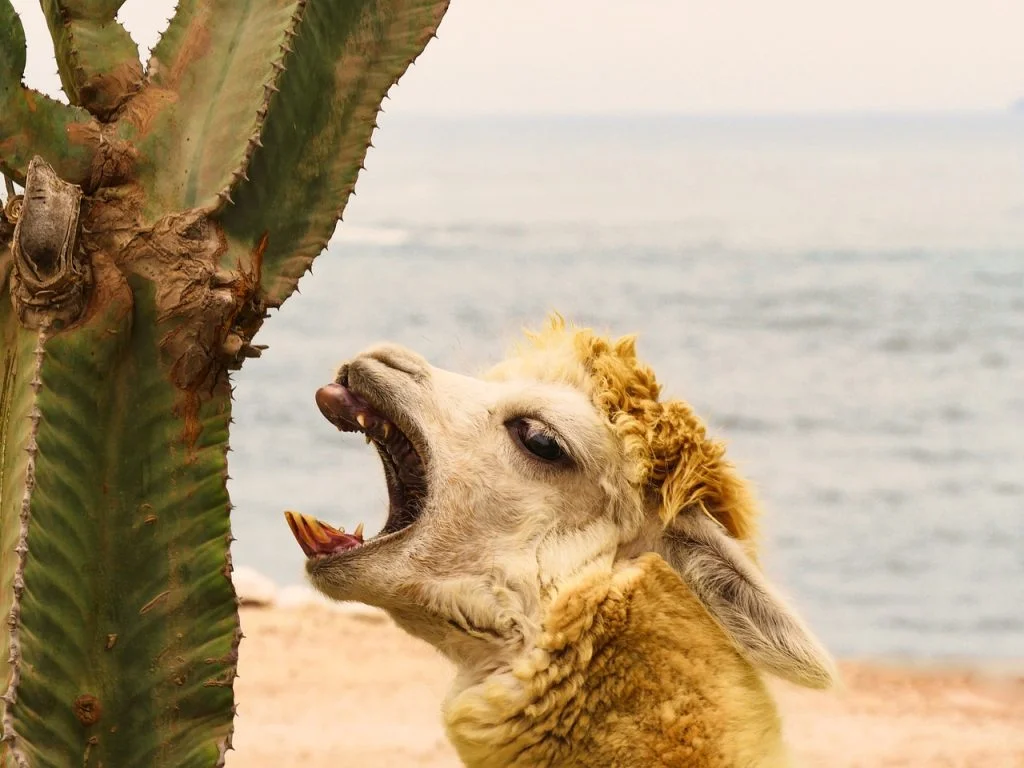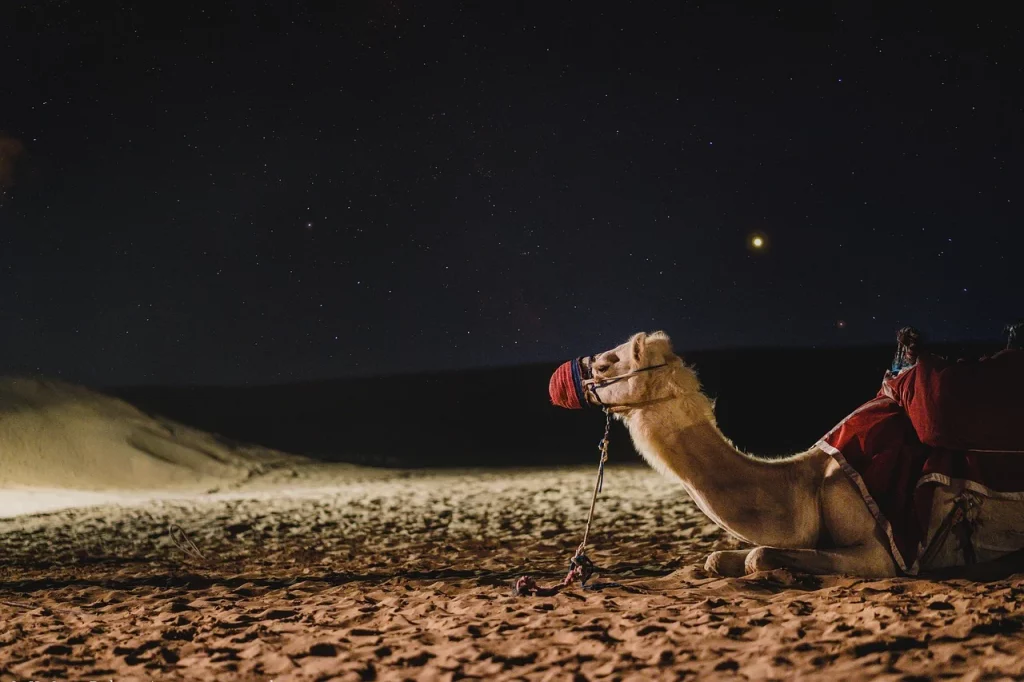Welcome to the epic world of camels, where every hump has a story and every grunt is gossip! Did you know that camels are the gossip queens of the desert? Oh yes, they’ve seen it all – from the ancient pyramids being built to the latest fashion in desert headwear. And let’s not even start on their ability to hold water better than the latest gossip.
Now, let’s grab your sunhat and embark on a sandy adventure to uncover some amazing facts about these desert celebrities. Are you ready to find out why camels might just be your new favorite animal?
A camel makes an elephant feel like a jet plane.
Jackie Kennedy
Camels Facts
Embark on a fascinating journey through the world of camels, where each fact is a step deeper into the desert of knowledge. Don’t forget, there’s a quiz awaiting at the end, so read carefully if you want to be a camel professional.
- Camels are members of the Camelidae family, which also includes llamas and alpacas.
- There are two main types of camels: the Dromedary, which has one hump, and the Bactrian, which has two humps.
- Dromedary camels are primarily found in the Middle East and Africa, while Bactrian camels are native to Central Asia.
- The humps on camels store fat, not water, as commonly believed.
- Camels can survive without water for up to two weeks due to their ability to conserve water.
- They can drink up to 40 gallons of water in one go when they find it.
- Camel milk is a staple in the diets of nomadic cultures in desert regions.
- A camel’s thick coat reflects sunlight and insulates them from the desert heat.
- Their eyes have three eyelids and two rows of eyelashes to protect them from sand.
- Camels can close their nostrils during sandstorms.
- Camel feet are wide and padded, helping them walk on sand without sinking.
- Bactrian camels can withstand temperatures ranging from -20°C to 50°C.
- Camels can run at speeds up to 40 mph in short bursts.

- They can maintain a speed of 25 mph for longer distances.
- Camel gestation lasts around 13 to 14 months.
- A baby camel is called a calf.
- Calves can walk within hours of birth.
- Camels have been domesticated for over 3,500 years.
- Camels were vital for trade routes, notably the Silk Road.
- Their ability to carry heavy loads for long distances made them ideal for long journeys.
- Wild Bactrian camels are critically endangered.
- Camels can eat thorny plants without injury due to their tough mouths.
- Their lifespan is typically 40 to 50 years.
- Camels can show emotions like joy and anger.
- They communicate with each other using body language and vocalizations.
- A group of camels is called a caravan, flock, or train.
- Camel racing is a popular sport in the Middle East.
- Camels are ruminants, meaning they chew cud like cows.

- They have a complex, three-chambered stomach.
- Their diet consists mostly of dry grasses and grains.
- Camels have been used in military campaigns throughout history.
- Their immune system is exceptionally strong and unique.
- Camel blood remains fluid at higher temperatures than that of other mammals.
- Camel hair is used in textiles and brushes.
- They can carry up to 900 pounds of cargo.
- Female camels usually give birth to a single calf.
- Mating season can be a noisy and competitive time for males.
- Their population in the wild is decreasing due to habitat loss.

- Camel’s unique gait is called pacing.
- They move both legs on one side of their body forward at the same time.
- This motion gives riders a swaying motion, known as the “camel’s pace.”
- Some cultures consider camel meat to be a delicacy.
- Their livers can withstand high levels of salt, allowing them to drink salty water.
- Camels have played a significant role in many cultures as symbols of endurance and resilience.
- They are often featured in folklore and art.
- Conservation efforts are in place for wild camel populations.
- Modern uses of camels include tourism and therapy animals.
- Camels have unique, oval-shaped red blood cells.
- They are capable of changing their body temperature to conserve water.
- Camels have an exceptional ability to adjust their body temperature, which ranges from 34°C to 41.7°C, to cope with the desert environment.
Camels Myths

Now that we’ve explored some fascinating facts about camels, let’s separate myth from reality. Can they actually store water in their humps?
- Camels Store Water in Their Humps
Camels’ humps do not store water; they store fat. This fat can be converted into water and energy when food and water are scarce. The hump’s ability to store fat allows camels to travel long distances through the desert without food. - Camels Spit Frequently as a Defense Mechanism
While camels can spit, it’s not as common as people think. They usually spit to deter predators or when they feel threatened. It’s more of a last resort than a go-to defense. - Camels are Native to the Middle East and North Africa Only
They are indeed synonymous with deserts in the Middle East and North Africa, but their original habitat is more diverse. They were once found throughout Central Asia, and even today, the Bactrian camel is native to parts of Central Asia. - Camels Cannot Run Fast
Despite their bulky appearance, camels are quite swift. They can run at speeds up to 40 miles per hour in short bursts and can maintain speeds of 25 miles per hour over longer distances. - Camels are Always Docile and Easy to Handle
They have a reputation for being calm and obedient, but they have unique personalities. Some can be stubborn or irritable, especially if not properly trained or treated well. It’s important to approach and handle them with care and understanding.
No products found.
Camels Quotes

Here are five of my favorite quotes about your new favorite animal. Let me know which one is your favorite in the comments.
The camel has a single hump; The dromedary, two; Or else the other way around. I’m never sure. Are you?
Ogden Nash
Ogden Nash playfully addresses the common confusion between camels and dromedaries, using his characteristic wit to highlight the subtle differences.
Camels can go many weeks without drinking anything at all. The notion they are carrying water in their humps is pure legend.
David Attenborough
David Attenborough, a renowned naturalist, dispels a common myth about camels, explaining their remarkable adaptation for surviving in arid environments without water.
An army marches on its stomach. Camels, which have three stomachs, show this better than anything else.
Napoleon Bonaparte
Napoleon Bonaparte uses the camel as a metaphor to emphasize the importance of logistics and sustenance in military campaigns, drawing an analogy with the camel’s unique physiology.
I prefer camels to cars because cars you have to drive; camels you have to understand.
King Hussein
King Hussein of Jordan reflects on the nuanced relationship between humans and animals, suggesting that understanding and empathy are more vital in dealing with camels than the mechanical operation of cars.
Camels can turn revenge into an art form, never forgetting a grudge.
Terry Pratchett
Terry Pratchett, known for his humorous and insightful observations, comments on the camel’s reputed memory and temperament, implying their capability to hold grudges with a hint of amusement.
Camels FAQ

Having soaked in the wisdom of camel quotes, let’s camel-trek into the heart of our FAQ section. Each answer is a step closer to mastering camel facts. And don’t stray off the path – a quiz awaits to challenge your desert knowledge!
- Are camels faster than horses?
Well, it depends on the distance! For short bursts, horses are faster, reaching speeds up to 55 mph. Camels, on the other hand, can reach up to 40 mph but excel in endurance. They can maintain a speed of about 25 mph for longer periods of time, which horses would struggle to match in hot desert conditions. - Can camels swim?
This might surprise you, but camels can swim! It’s not something they do often, but in places like the Ganges River in India, camels have been seen swimming across water bodies. They’re not Olympic-level swimmers, but they certainly can manage to cross rivers when needed. - How do camels store water?
It’s a common myth that camels store water in their humps. In reality, the hump stores fat, which the camel can convert into water and energy when food and water are scarce. Their ability to avoid water loss is more about their remarkable kidney and intestine efficiency, and less about water storage. - Are camels native to Australia?
No, camels are not native to Australia. They were introduced there in the 19th century from places like India and Afghanistan to help with exploration and transportation in the Australian outback. Today, Australia has the largest population of feral camels in the world. - Can camels eat cactus?
Yes, camels can eat cactus! Their thick lips and unique mouth structure allow them to munch on these prickly plants without much trouble. It’s a useful adaptation for surviving in harsh, arid environments where other food sources are scarce.
No products found.
Camels Trivia

Get ready for a hump-tastic journey with my Camel Quiz! Fail to answer correctly, and you might just find your next Uber ride replaced by a stubborn, sandy camel.
Conclusion
In conclusion, camels are not just desert taxis with a bad attitude; they are fascinating creatures with unique adaptations. They can survive in harsh conditions where most of us would just end up as a mirage.
Next time you forget your water bottle at home, think of them and ask yourself, “Could I survive a day in their hooves?” How long do you think you’ll last? Tell me about your camel-like resilience (or lack thereof)!
5 Sources Used For This ArticleThe Fascinating History And Culture Of Camel Riding In The Desert – Camel Advisor
Weird And Interesting Facts About Camel – Pashudhanpraharee
Why Do Camels Have Humps – Animal Safari
14 Camel Facts About the Humped Desert Beasts – Trvst


